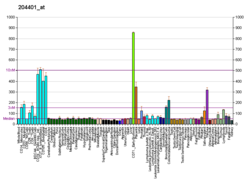Top Qs
Timeline
Chat
Perspective
KCNN4
Protein-coding gene in the species Homo sapiens From Wikipedia, the free encyclopedia
Remove ads
Potassium intermediate/small conductance calcium-activated channel, subfamily N, member 4, also known as KCNN4, is a human gene encoding the KCa3.1 protein.[5]
Remove ads
Function
The KCa3.1 protein is part of a potentially heterotetrameric voltage-independent potassium channel that is activated by intracellular calcium. Activation is followed by membrane hyperpolarization, which promotes calcium influx. The encoded protein may be part of the predominant calcium-activated potassium channel in T-lymphocytes. This gene is similar to other KCNN family potassium channel genes, but it differs enough to possibly be considered as part of a new subfamily.[5]
Remove ads
History
The channel activity was first described in 1958 by György Gárdos in human erythrocytes.[6] The channel is also named Gardos channel because of its discoverer.
See also
References
Further reading
Wikiwand - on
Seamless Wikipedia browsing. On steroids.
Remove ads





